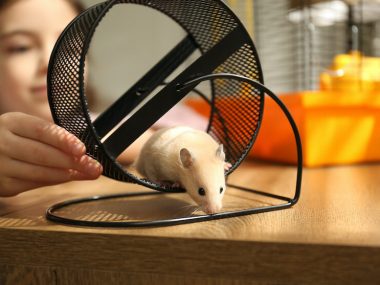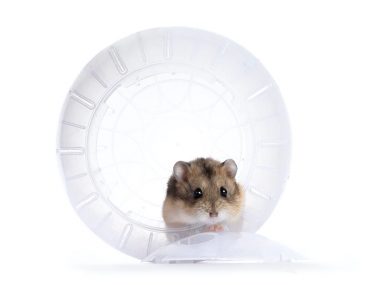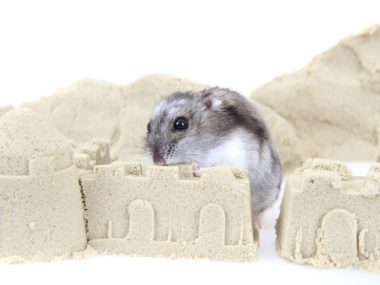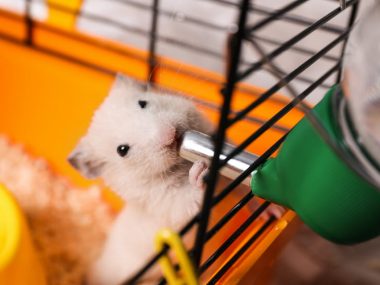Everyone loves a puzzle, and that includes your hamster. Of course, you can’t give your hamster a real 100-piece picture puzzle, or it will quickly get chewed up, but you can create an exciting hamster maze that will be fun for you to make and even more fun for your little pet to solve.
Hamsters are curious creatures that enjoy exploring. Mazes provide environmental enrichment and satisfy a hamster’s natural tunneling and burrowing instinct. Mazes can be purchased as prefabricated kits or can be inexpensively created using common household materials.
Mazes are a great way for owners to play with their hamsters and allow them the freedom to explore new spaces without any danger of them getting lost. Let’s cover some basic tips and then get onto the fun part of creating a 3D hamster maze experience!
Table of Contents
Hamster Mazes – What To Do And What Not To Do
Before we collect our materials to get started, there are a few things to keep in mind. Many a hammie parent has ordered a kit or spent time building a maze only to be disappointed when they find it unsuitable for their pet.
So let’s take a quick look at what makes a good maze that will be fun for your hamster and entertaining for you to watch.
Things to remember when creating a maze for your hamster:
| Make the side walls high or include a well-ventilated cover on the maze | Your curious hamster won’t realize it is in a maze and will quickly jump over the side walls if it can. |
| Ensure the maze is large enough for your hamster to fit through the passages | Many hamster owners have purchased a maze kit only to find it is only suitable for mice or dwarf hamsters. If you have a larger breed like a Syrian hamster, it may not fit through a tiny maze. |
| Only use hamster-safe materials. | Check that the glue you use is non-toxic. If you use wood, ensure that it is safe, and everything you include inside the maze should be safe for your hamster to rub against or chew. |
| Safety first | Ensure that you can keep track of the hamster as it moves around the maze, and it can’t get stuck anywhere without you knowing. |
| Don’t underestimate your hamster’s ability to escape | Place your maze inside a safe area while playing with your hammie – preferably at ground level. An empty bathtub with the plug inserted and a towel over the bottom is a good option |
| Keep ventilation inside the maze a priority | If you need to add a lid on top of the maze to keep your hamster in, ensure that it provides adequate ventilation. Avoid using a solid sheet of transparent plastic or similar. |
What Is The Difference Between A Hamster Maze And A Tunnel?
Many hamster cages come equipped with transparent tube tunnels for the little animals to dart through. In the wild, hamsters would carve out elaborate underground tunnels, and they do seem to enjoy crawling through pipes and tubes. A short tunnel is often a permanent fixture in a hamster cage.
A hamster maze is a puzzle for your hamster that allows it to exercise its brain and body to find its way through a series of passages. Small rewards can be placed along the way, and it can be fun to time your hamster to see how fast it learns to find its way to the other side.
Hamster mazes can include short pieces of tunnel. If using items like PVC or plastic bottles as pipes, ensure that there are holes in the sides for ventilation.
How To Make A Hamster Maze
A hamster maze doesn’t need to be purchased to be an exciting game that will entertain you and your hammie. While your hamster may not be as smart as a dog, they certainly are curious and intelligent little creatures that enjoy exploring.
There are many ways to make a simple DIY cardboard maze that will be as much fun as a bought version, and you can recycle things you find around the house.
Here’s What You Will Need To Make A Hamster Maze
- A solid base in the size that you want to build the maze. A thick cardboard box works well for this. For your first maze building attempt, don’t go bigger than 2ft by 2ft. You want to be able to see your hamster at all times.
- Non-toxic glue. A hot glue gun works well, but you can use any non-toxic glue.
- Thick cardboard to make the walls – The cardboard needs to be thick enough to be securely stuck down on its thin edge. Thick cardboard boxes work well.
- A utility knife and ruler – Use a ruler and a utility knife to shape the wall material.
- A simple design – this should include a clear entry and an exit. Keep it simple and choose a shape that will fit the size base that you have. There are plenty of free simple maze templates you can choose from, or you can design your own.
- Marker to trace the design onto the base
- Interesting features you want to include, like short cardboard tubes.
Method To Create A DIY Cardboard Hamster Maze
- Your thickest box should form the base and outside frame of the hamster maze. Cut the sides down, so they are at least twice the height of your hamster. If it is too low, the hamster will be able to climb out.
- The maze should have one entry and one exit point on opposite sides.
- Glue down strips of thick cardboard to form the inside maze walls. Keep the design simple. Remember to keep your hamster’s size in mind. It must be able to turn around in dead-end sections.
- Add a few short cardboard tubes for your hamster to crawl through for some extra fun. Pringles tubes work well for bigger hamster breeds, while dwarf hamsters usually fit through bathroom tissue rolls.
- Add a small amount of your hamster’s bedding to the bottom of the maze, so it’s more comfortable and smells familiar.
- Include a few small healthy treats along the way or at the end. Your hamster will learn to navigate the maze quickly to get the food reward at the end.
Always play with your hamster in the maze in a safe place. It must never be on a table where the hamster could fall or somewhere where the hamster could escape and run away.
If you aren’t too good at DIY but would love to have a maze for your hamster, maze kits are available. Here are our top 2 picks:
| Pros | Cons |
| Playtime Maze Reconfigurable Maze – The neat thing about this maze is that you can keep changing the configurations. Keep your hamster engaged and interested as it solves each new pattern. – Can be linked together with more units to be made larger – Made of light, durable plywood, its stronger than cardboard mazes | – This maze is only suitable for dwarf hamsters and is too small for larger breeds. – It comes with a plastic lid, but ventilation may not be good. |
| Fhiny Hamster House Maze – this durable maze has 15 holes that allow your hamster to explore different areas. – It is suitable for larger hamster breeds – It is made of natural wood – Includes an extra level on the roof with a food bowl to encourage hamsters to climb – A nice addition to add inside the hamster cage | – It does not have enclosed sides, so the hamster may get off track if you want it to move through the maze in a specific direction. |
When Is The Best Time To Put My Hamster In A Maze?
If you have made a maze for your hamster, the best time to introduce your pet to the stimulating new game is early evening. This is because hamsters are mostly nocturnal, and you can expect your little pal to be a lot more excited about the game when it has rested well and waking up for the night.
If you and your hamster have a comfortable routine of playtimes, and the little animal is relaxed, it will probably enjoy exploring a maze any time. However, if you need to wake your pet up from a sound sleep and put it inside a new environment, it may be a little frightened. Imagine someone wakes you up from a deep sleep at 3 am, and you find yourself inside a completely unknown room!
Frequently Asked Questions
Are Mazes Good For Hamsters?
Mazes are a great way to provide enrichment for your hamster. It will relieve boredom, and your little pet will get some exercise while enjoying the extra mental stimulation. Lack of activity in hamsters can lead to lethargic behavior or even obesity, so providing a maze is an excellent way to get your hamster moving and exploring the fun activity.
Do Hamsters Like Obstacle Courses?
Hamsters love exploring, and so long as they can climb small bridges or scale small climbing walls or logs, they most definitely will try. Providing enrichment activities for your hamster will keep it happy and healthier for longer.
Keep safety as the top priority when including obstacle course elements in a hamster maze. Your hamster may not see sharp drop-offs, or they can get stuck in pipes that are too narrow.
Why Does My Hamster Like A Maze?
Wild hamsters naturally burrow and dig tunnels. A maze allows your hamster to go back to its wild roots and move through a series of narrow passages leading into or out of a burrow-like area. Adding interesting snacks or small obstacles along the course can add extra incentives for the small pet.
Hamsters can’t see very well. They rely on senses like hearing, touch, and smell to navigate. A securely constructed maze allows a hamster to explore confidently, even with limited eyesight.
How Do You Make A Big Hamster Maze?
Once your hamster has become an expert at solving its current maze, you may want to change things up or extend it. A great idea is to build a new maze and then create a series of attachment tunnels from one maze to the other.
Use portions of plastic hamster tubes or make interconnection tunnels between the mazes using roller towel inner tubes. Ensure that tubes have adequate ventilation holes in case your hammy drifts off for a nap inside one of the tubes. Creating new mazes and linking them will make your hamster maze much bigger. This system also lets you stack the mazes on top of each other when you are not playing with your hamster so that they will take up less space.
References:
https://oxfordre.com/neuroscience/view/10.1093/acrefore/9780190264086.001.0001/acrefore-9780190264086-e-226
https://animals.mom.com/homemade-hamster-maze-6262.html






